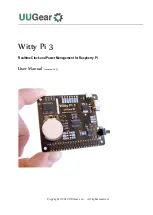
44
BAS-SVX084A-EN
Calibration, Operation Modes, and Control
–
For electric reheat, the unit is in Pressure Independent mode or the Pressure Dependent
Mode Reheat Enable point is enabled.
Electric Heat
Electric Heat Pulse-width Modulation (PWM)
Single-duct units can have from one to three stages of electric heat pulse-width modulation. Fan
powered units can have up to three stages of electric heat pulse-width modulation. Energizing for
a portion of a three-minute time period modulates the electric heater. This allows exact load
matching for energy efficient operation, and optimum zone temperature control. The Airflow
Setpoint Minimum Local Heat is enforced during reheat. The amount of reheat supplied is
dependent on both the degrees that the space temperature is below the active heating setpoint and
the time that the space temperature has been below the active heating setpoint. If not already OFF,
reheat de-energizes when the zone temperature rises more than 0.5°F (0.28°C) above the heating
setpoint. When reheat is de-energized, the cooling Airflow Setpoint Minimum is enforced.
•
Stage 1;
the ON time is proportional to the amount of reheat required. For example, when 50%
of stage 1 capacity is required, reheat is ON for 90 seconds and OFF for 90 seconds. When 75%
of stage 1 capacity is required, reheat is ON for 135 seconds and OFF for 45 seconds. When 100%
of stage 1 capacity is required, reheat is ON continuously.
•
Stages 2 and 3
; the same ON time logic as stage 1, except stage 1 is always energized. For
example, when 75% of unit capacity is required, stage 1 is energized continuously, and stage
2 is ON for 90 seconds and OFF for 90 seconds.
Electric Heat SCR
SCR is a heat controller that controls a single stage electric heater proportional to an analog signal.
The analog output signal is proportional to the amount of reheat required. Typically with SCR heat,
the heater is turned on and off on a very short cycle time to provide proportional control of heat
output. This allows for closer matching of heating capacity to the heating load, resulting in more
stable temperature control.
When the space requires cooling, the air valve modulates between Airflow Setpoint Maximum and
Airflow Setpoint Minimum, to maintain space temperature at the active cooling setpoint; and the
electric heater is off. When the cooling load has decreased to the point where the air valve has
reached Airflow Setpoint Minimum, space temperature is allowed to drift downward, in the
deadband between the active cooling setpoint and active heating setpoint.
When the space temperature drops below the active heating setpoint, the air valve opens to the
Airflow Setpoint Reset Minimum Local Heat and the SCR controls the electric heater to maintain
space temperature at the active heating setpoint. SCR control is dependent on the degree that the
space temperature is below the active heating setpoint and the amount of time that the space
temperature has been below the active heating setpoint.
If the discharge air temperature reaches the Discharge Air Temperature Design Setpoint, the air
valve opens further and modulates between Airflow Setpoint Reset Minimum Local Heat and
Airflow Setpoint Reset Maximum Local Heat to maintain space temperature at the active heating
setpoint, while the SCR controls the electric heater to maintain discharge air temperature at the
Discharge Air Temperature Design Setpoint (see
). If the air valve reaches Airflow
Setpoint Reset Maximum Local Heat, the SCR controls the electric heater to maintain space
CAUTION
Safety and Maintenance!
Trane does not recommend enabling electric reheat in pressure dependent mode. There are
potential safety and maintenance issues that can occur if the electric reheat is allowed to
energize when the airflow passing over the element is too low or is below the Airflow Setpoint
Minimum Local Heat. Refer to the equipment catalog for Trane F-Style VAV boxes for minimum
airflow settings based on box inlet size and heating element kW.
















































